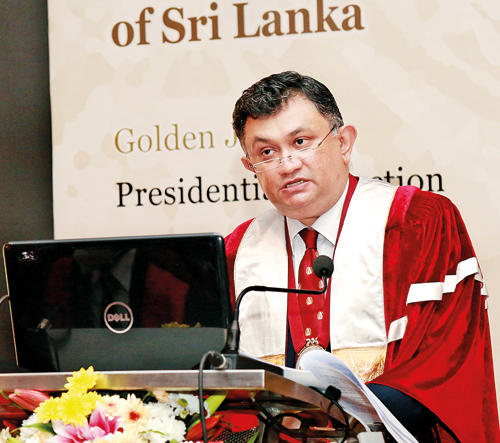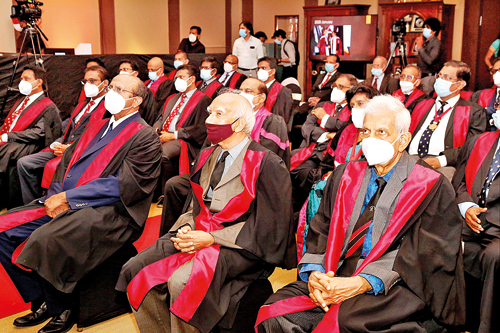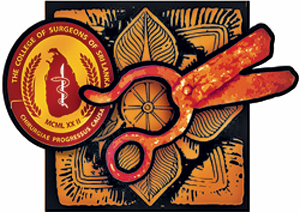Small country rich in its history and future in surgery

Prof. Srinath Chandrasekera
Just after her first birthday, a very ill baby-girl from a humble home in Jaffna is taken to the Teaching Hospital in the area. She has renal failure due to huge stones in both her kidneys. Treatment at the Jaffna Hospital is possible through large cuts on her abdomen and the surgeons there make quick calls to their colleagues in Colombo.
Things happen quickly thereafter – the baby, along with her parents who have never left their home area before, is brought to Colombo in an ambulance, the little one undergoes keyhole surgery and soon they are back home with her kidneys fully functional and hardly-visible scars, with no cost to her impoverished parents.
To the south of Jaffna, in Anuradhapura, a farmer is rushed in a tractor to the Teaching Hospital in the area. Amidst the bloodied mess, the doctors see that the young man does not have a hand. Accidentally getting caught to the unprotected high-speed blower-fan which is used to separate the good paddy (wee) from the chaff, the hand has been “guillotined” and lies in a bag. The Anuradhapura surgeons rush him to the operating theatre.
A few months later, the farmer is back in the fields, the hand functional after an eight-hour meticulous re-implant.
These are just two of the surgical feats from hospitals across the country and show how Sri Lanka’s health service in general and surgical services in particular support the poorest of the poor from any part of the country.
This is how whether it is elective surgery (such as removal of growths, both benign and malign) or emergency surgery (involving trauma), the scalpel has been and is being wielded with responsibility by the medical fraternity of ‘surgeons’.
As the College of Surgeons of Sri Lanka (CSSL) with its base as the charming home of Noel and Nora Bartholomeusz in Cinnamon Gardens, celebrates its golden jubilee, the task of taking them forward has fallen on the shoulders of Consultant Urological Surgeon Prof. Srinath Chandrasekera.
Prof. Chandrasekera looks back and then forwards to where the country and its surgeons should be in the next 50 years after being inducted as the CSSL President in a poignant hybrid ceremony (physical and on Zoom) on January 15.
He harks back to the foundation on which the 50-year-old college is built, as he says that long before they came together as a formal group in 1971, this tiny island had an excellent surgical tradition.
In an exclusive interview with the Sunday Times, Prof. Chandrasekera talks of all that is small but beautiful.
“Do you know that we have a rich history of surgery going back to the Anuradhapura and Polonnaruwa Periods, where among the archaeological finds are a hospital complex at Mihintale dating back to 200 BC renowned as the first of its kind recorded in the world and surgical instruments such as scalpels, forceps and scissors from the Alahana Pirivena,” he asks.
Many centuries later, in the late 1970s and early 1980s, came another milestone when there was a change in the postgraduate training of potential surgeons. Earlier, they had to head to the United Kingdom (UK) which caused some limitations in the numbers. With the setting up of the Postgraduate Institute of Medicine (PGIM), the doors opened for a larger number to take up this important specialization of medicine.

The august gathering at the induction ceremony
The numbers speak for themselves – whereas in 1971 there were only a few surgeons, by 2020 Sri Lanka had more than 600 surgeons spread across the whole country.
It is with pride that Prof. Chandrasekera points out that these surgeons are from all 10 main branches, while there has also been a gradual development of sub-specialties, with the CSSL getting the support of other stakeholders including the Health Ministry and the PGIM.
These main branches are urology; orthopaedics; neurosurgery; paediatric surgery; cardiothoracic surgery; plastic surgery; onco-surgery (cancer surgery); vascular surgery; gastro-enterology; and general surgery which has developed with special interest areas.
“Each of the nine provinces has surgeons. Any man, woman or child has access to a specialist surgeon within 1½ hours from any remote corner, be it Point Pedro or Dondra Head, Galle or Jaffna or Mannar or Arugam Bay,” he says.
Underscoring that the key to the strong network of skilled surgeons has been the high quality of training and examinations over the past 40 years, always with external reviewers, the new CSSL President is quick to point out that this has resulted in quality assurance coming from the highest authority in the UK – the Joint Committee for Inter-Collegiate Examinations of all the Royal Colleges of Medicine and Surgery.
“This Joint Committee has unequivocally declared that Sri Lanka’s MD-Surgery is on par, ‘as good as’, the Membership of the Royal College of Surgeons (MRCS),” he smiles, stressing that with this stamp Sri Lankan surgeons are recognized anywhere else in the world, while they can simply apply and obtain the MRCS-Glasgow without sitting for that examination. This reflection of high standards is a first in the world and an honour not only for the country’s surgeons but also for Sri Lanka.
He talks of all the links the CSSL has with other eminent surgeons’ groups around the globe, while the headquarters of the South Asian Association for Regional Cooperation (SAARC) Surgeons is the CSSL.
| CSSL’s vision to make SL a surgical hub | |
| Finding ways and means of serving the people of Sri Lanka better, is what Prof. Srinath Chandrasekera and his council are looking at, as he stands at the helm of the CSSL. The biggest challenge is the COVID-19 pandemic which has led to a restriction in the delivery of surgical services and they are making every effort to sustain and enhance their services, he says.
“We need a holistic approach not only medium but also long-term to prevent these accidents,” he says, pledging that the CSSL will work closely with the government, occupational and public health sectors and also the media. Prof. Chandrasekera and his council, meanwhile, hope to take Sri Lanka’s excellent surgical services to the global platform. “This is our long-term vision.” Sri Lanka as a surgical hub is what is being envisioned, so that after the next 50 years, the CSSL can tower above, as it is now doing – on the shoulders of giants of surgery who have gone before them. It is with this on the horizon that the Embekke symbol, the Pe-kada (the drooping lotus that crowns the ornate columns), has been incorporated in the logo of the CSSL to epitomize that ‘Science meets Art even as the resonance of a gloried past nurtures the present stature of the college’. “Like the Pe-kada, we stand on the shoulders of a surgical heritage spanning millennia. Much like the Pe-kada, the college is the Great Intermediary – the device that lets this great pillar of surgery branch out into the beams, the rafters and ultimately completes the roof that is surgical care in Sri Lanka,” says Prof. Chandrasekera, adding that the ‘Lotus and the Scissor’ symbolize the quest for excellence in education, innovation and healing. |




 Prof. Chandrasekera picks up a major concern of the CSSL, the need to bring down the large number of trauma cases including road traffic accidents and industrial, agricultural and domestic accidents. The most common cause of hospital admissions in all districts in the past 17 years has been trauma, with 3,000 deaths per year from road traffic accidents.
Prof. Chandrasekera picks up a major concern of the CSSL, the need to bring down the large number of trauma cases including road traffic accidents and industrial, agricultural and domestic accidents. The most common cause of hospital admissions in all districts in the past 17 years has been trauma, with 3,000 deaths per year from road traffic accidents.